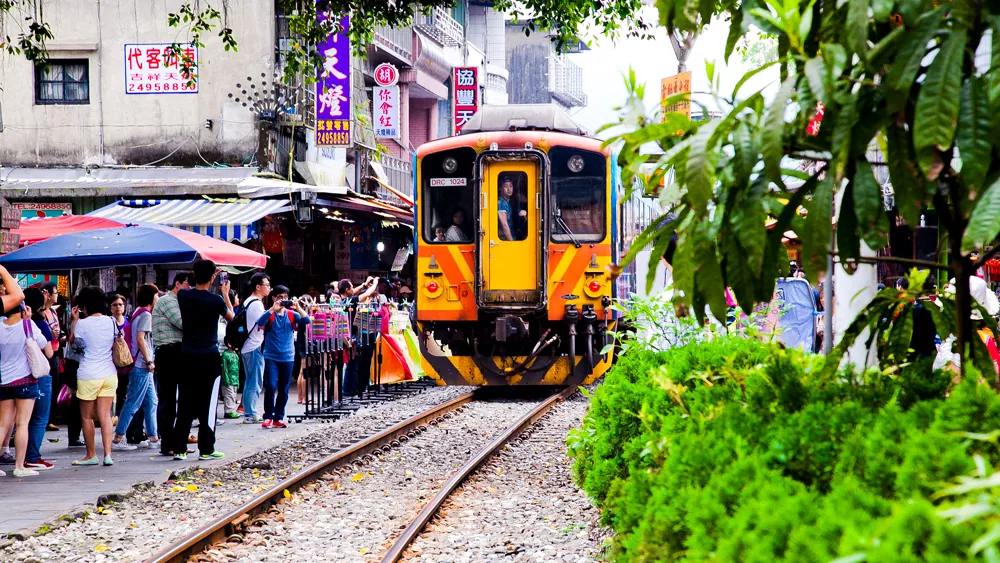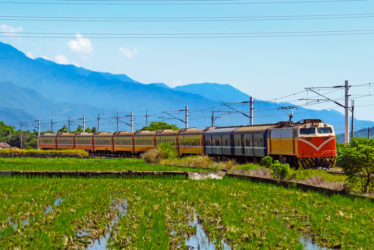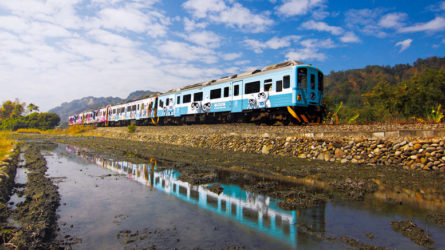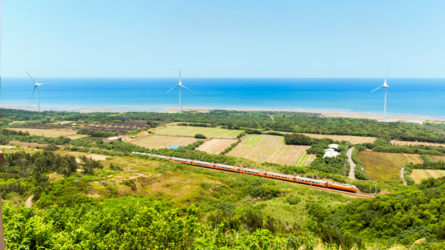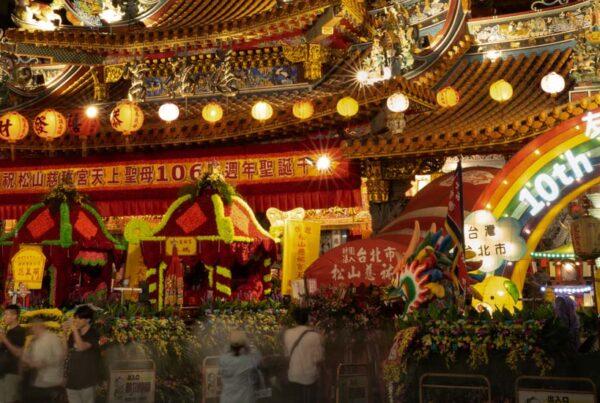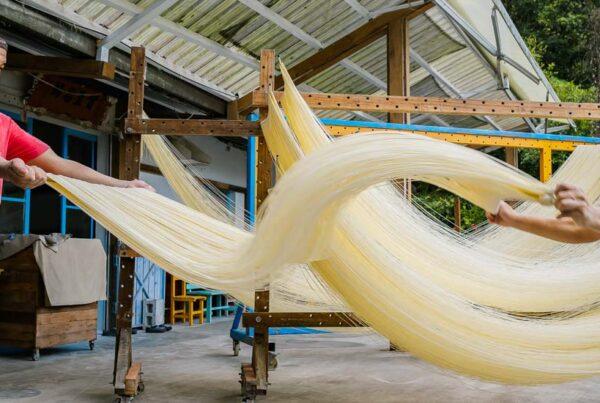
Riding the Pingxi Line in New Taipei City is a journey into the past, as well as a jaunt into lush and scenic countryside that feels hundreds of miles from busy and crowded central Taipei, which is in fact just a quick bus or train trip away.
Text: Richard Saunders; Photos: Vision
With a modern railway line encircling the island, and a high-speed rail service zipping down its west coast connecting major cities, Taiwan has an excellent railway service. The island’s first railway, connecting Keelung in the northeast and present-day Hsinchu in the northwest, was completed in 1893; it was one of the first to be built in Greater China. After the Japanese took control of the island in 1895, they continued the modernization of its infrastructure by building a line connecting Keelung and Kaohsiung in the south, completed in 1908.
While improving access to all island areas was a major aim for Taiwan’s colonial rulers when building the railway system, it wasn’t the only one. Coal was first mined in the 1870s, at pits on Taiwan’s northeast coast, and later in other parts of northern Taiwan as well. To transport the black gold, several short rail lines, including the 12.9-kilometer-long Pingxi Line (finished in 1921), which traverses the picturesque Pingxi Valley, were built. The line escaped closure after the area’s mines were abandoned in the late 20th century; today it has become one of Taiwan’s most popular tourist-railway attractions, and a must-experience for visitors to the northern part of the island!
KLOOK: Pingxi Shifen Half Day Guided Tour with Sky Lantern Experience (Downtown Taipei Shuttle Service)

In 1936, another railway line serving mining purposes was built along the coast, connecting Keelung, Badouzi, Shen’ao, and Shuinandong. This was the original Shen’ao Line, used until 1962. Three years later a new line was opened, using part of the original line and now connecting Ruifang, instead of Keelung, with Shen’ao and Shuinandong. The full line was in operation until 1989, then a portion of it until 2007, when the Shen’ao Power Plant it had been serving was dismantled. With the opening of the National Museum of Maritime Science and Technology (NMMST) on the original site of the Northern Power Plant in 2014, a 4km stretch of the Shen’ao Line was revived, connecting Ruifang and a newly constructed station close to the museum, Haikekuan (an abbreviation of the museum’s Chinese name). To the delight of railway lovers and tourists, last December a second station was added to the line, Badouzi, right by the coast.
Slow commuter/tourist trains now run between Badouzi in the northeast and Jingtong Railway Station in the southwest, combining the Shen’ao Line and the Pingxi Branch Line. At Ruifang Railway Station travelers can transfer to trains running on the main railway line between Taipei and Yilan.
There’s a lot to see between Haikeguan and Jingtong, so you might want to pick up a Pingxi Line 1-Day Pass (NT$80), which allows unlimited travel (and stops) along the length of what the Taiwan Railways Administration collectively calls the Pingxi/Shen’ao Line. Tickets are sold at the Taipei, Songshan, Keelung, Ruifang, and Yilan railway stations, as well as some of the stations on the Pingxi Branch Line. If you’re just stopping at a couple of the stations, note that an EasyCard (a popular Taiwan smart card) can also be used.

Let’s Take the Pingxi Line!
Badouzi Station
Start the day off by taking the train first from Ruifang to Badouzi. What makes this tiny station special – and beloved by railway aficionados – is its location. It sits right beside the coastal highway, just a stone’s throw away from the waves crashing against the scenic rocky northeast coast shoreline. The original railway line extended from here further east to Shuinandong, where the main road from the tourist villages of Jiufen and Jinguashi meets the coast. Currently, the New Taipei City Government is assessing the feasibility of creating a bike path along the original line between Badouzi Station and Shuinandong, which would make for a fantastic cycling experience along the coast.

Haikeguan Station
Get off at this station to visit the National Museum of Marine Science and Technology. Follow the signs from the station to the museum, passing through a lovely ‘tunnel’ of banyan trees (a walk of about five minutes). The main exhibition building of the museum (developed from the original structures of the old power station) houses eight exhibition halls on four floors, and is chock-a-block with such creative and colorful displays as the Marine Science Gallery, which at first glance looks as though it found its way here from the Taipei Astronomical Museum. Large, glowing orbs representing the Earth explain the complexities of ocean currents and other things natural in easy-to-understand language, while striking hands-on installations explain other strange marine phenomena. Don’t miss the hourly sound-and-light show in the Deep Sea Theater on the third floor, housed in the dark, cavernous expanse of what was originally the power plant’s boiler room.


If you want to spend more time on the coast, note that there is a popular fishing harbor, Badouzi, and a scenic coastal-cliff area, Wangyou Valley, close by.
Add: No. 367, Beining Rd., Zhongzheng District, Keelung City
(基隆市中正區北寧路367號)
Tel: (02) 2469-6000
Website: www.nmmst.gov.tw
Ruifang
After visiting the marine museum, take the train back to Ruifang. The main reason to get off at this town is to take a side trip to the very popular tourist spots Jiufen and Jinguashi, two mountainside villages overlooking the sea. There are regular buses that run to both villages from the bus stop on the main road (about 100 meters to the left after exiting the station).


Houtong
The first stop after passing Ruifang, the village of Houtong, is the site of the open-air Coal Mine Ecological Park (which opened in 2011), and the most complete surviving coal-mining community in Taiwan. Most visitors, however, come to see its famous stray cats! Around 2008, local animal lovers started caring for abandoned cats. The majority of these cute kitties now live in a traffic-free area (“Cat Village”) of Houtong across the railway tracks from the main part of Houtong, and these friendly felines (which number over a hundred these days) are remarkably unfazed by all the attention they receive from adoring visitors.



Much of the village seems to be centered around the cats these days – a couple of souvenir shops next to the train station do a roaring trade in cat-themed merchandise, while images of cats (painted, drawn, cut, and sculpted) adorn surfaces everywhere. To get to “Cat Village,” simply turn right immediately after passing through the ticket barrier of the railway station, walk up the stairs, and cross over the rails via the pedestrian overpass, the roof of which has the shape of, you guessed it, a large cat.
Sandiaoling
Most regular tourists don’t get off the train at the next station, Sandiaoling; but many hikers do, because there is a great and easy-to-follow trail that has become quite popular in recent years. Sandiaoling Waterfall Trail starts beside the abandoned elementary school in Sandiaoling village and follows a tributary of the Keelung River upstream through thick forest and past a series of three spectacular waterfalls, the second of which pours over a very large overhang where visitors can stand, safe and dry, behind the curtain of water.

Motian Waterfall (left) and Pipa Cave Waterfall (right)


Shifen
Continuing inland, beyond Sandiaoling the branch line follows the river through a scenic wooded gorge. The train is soon plunged into darkness as it enters the first of four tunnels on the line. For much of the way to the next station, Dahua, the train is either underground or the tracks and the river are crammed side by side in a rocky ravine. Try to get a seat on the right-hand side to get the best views. After rain, tributary streams course down both sides of the gorge in a series of small waterfalls.
After passing tiny Dahua Station, the train emerges from the last tunnel on the branch line, rolls over a long bridge high above the river, and runs straight down the center of the main street of Shifen before coming to a halt at this village’s station. Shifen is one of the most popular stops on the line.

All kinds of Taiwanese snacks, from shaved ice and popsicles to grilled sausages and stinky tofu, can be sampled in the main street, which is also a great place to make, decorate, and set off a sky lantern. Write wishes or messages with brush and paint on the sides of a meter-tall paper lantern, fix a wad of “ghost money” inside, and after lighting the money allow the lantern to float up into the sky, where the wishes will hopefully be communicated to the gods!

Follow the crowd that gets off at the railway station to the northeastern end of Shifen Old Street, follow the main highway until you reach a fork, and take the road to the right to get to the Shifen Visitor Center and, further on, to the magnificent Shifen Waterfall. After heavy rainfall, this 30-meter-wide curtain of water is awesomely powerful, hence its nickname, “Taiwan’s Niagara Falls.” After enjoying the waterfall, cross the Waterfall Viewing Suspension Bridge right beside the railway line and return to Shifen on the main highway.

Foreigners in Taiwan: Taiwan Coal Mine Museum 台灣煤礦博物館
Lingjiao
Beyond Shifen, the Pingxi Branch Line traverses a gentler countryside, passing the blink-and-you’ll-miss-it settlement of Wanggu before reaching Lingjiao. Immediately below the station, the Keelung River plunges over Lingjiao Waterfall, a striking sight after heavy rain. Follow the train tracks back towards Shifen for a couple of minutes to the entrance of a short trail on the right that leads down to the foot of the waterfall.

Foreigners in Taiwan: Wanggu Waterfall 望古瀑布
Over the City: Pingxi Valley Sites: Lingjiao and Wanggu: Waterfalls and Coal Mines
Pingxi
Pingxi, the second-to-last station on the line, lies beside the infant Keelung River. Life in its narrow streets goes on much as it did many decades ago. Above the police station, Guanyin Temple affords a fine view over the village and the mountains opposite. Nearby is the Cave of the Eight Immortals, a narrow tunnel carved out of soft sandstone. Pingxi Old Street is another great place to chow down on various cold and hot snacks served up in quaint little eateries. Sky lanterns can be launched right from the train tracks near the railway station. Note that the area around Pingxi also has numerous hiking trails, the most popular of which takes you to some peculiar and thrilling mountains, known by hiking expats as the Pingxi Crags.

Josh Ellis Photography: Pingxi Crags Hike
Over the City: Pingxi Valley Sites: Pingxi Town and Hiking the Crags
Klook: Pingxi Sky Lantern Blessing in New Taipei
Jingtong
The terminus of the Pingxi Branch Line, Jingtong station is a lovely old wooden building dating back to the Japanese colonial period. Just outside is Jingtong Old Street, a narrow and colorful alleyway that runs alongside the railway tracks, lined with eateries and food stalls plus, of course, shops selling sky lanterns. Segments of bamboo scrawled with the hopes of lovers hang from the fence bordering the railway. Another favorite place to fix these expressions of undying love is, naturally, the Lovers’ Bridge, which spans the river just below the station, reached by a flight of steps.
Coal was discovered at Jingtong in 1907 and the area once enjoyed the reputation of producing Taiwan’s finest. Spooky old mine workings lie a trail on the hillside just above the station. Two of the mine buildings have been turned into coffee shops: great places to kick back, relax, and enjoy the beauty of the surrounding hills.


Turn right out of the station, cross the main highway, and follow the path opposite down past the Japanese-era Taiyang Club. Cross the infant Keelung River, climb the stone steps on the left, and at the top is the famous Huang Gong Tea House, set in a beautiful Japanese-style building which has been featured in many TV series, adverts, and even a few movies. It’s the perfect place for a relaxing break after exploring some of the many attractions along this very special railway line.
Add: No. 5, Baishijiao, Baishi Borough, Pingxi District, New Taipei City
(新北市平溪區白石里白石腳5號)
Tel: (02) 2495-2021
Hotels in Pingxi Area
Hotels in Ruifang District
TAITUNG Train Ride — Lovely Countryside!
taiwaneverything.cc/2017/06/27/taitung-train/
Let’s Ride the JIJI LINE in Central Taiwan!
taiwaneverything.cc/2017/06/30/jiji-line/
MIAOLI COAST Railway Trip — Quiet and Peaceful
Also read:
Sky Lanterns and the Historical Pingxi Railway, Taiwan

